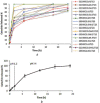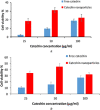Preparation and in vitro evaluation of novel cross-linked chondroitin sulphate nanoparticles by aluminium ions for encapsulation of green tea flavonoids
- PMID: 30104449
- PMCID: PMC8676605
- DOI: 10.1049/iet-nbt.2017.0298
Preparation and in vitro evaluation of novel cross-linked chondroitin sulphate nanoparticles by aluminium ions for encapsulation of green tea flavonoids
Abstract
Chondroitin sulphate is a sulphated glycosaminoglycan biopolymer composed over 100 individual sugars. Chondroitin sulphate nanoparticles (NPs) loaded with catechin were prepared by an ionic gelation method using AlCl3 and optimised for polymer and cross-linking agent concentration, curing time and stirring speed. Zeta potential, particle size, loading efficiency, and release efficiency over 24 h (RE24%) were evaluated. The surface morphology of NPs was investigated by scanning electron microscopy and their thermal behaviour by differential scanning calorimetric. Antioxidant effect of NPs was determined by chelating activity of iron ions. The cell viability of mesenchymal stem cells was determined by 3-[4, 5-dimethylthiazol-2-yl]-2, 5-diphenyl tetrazolium bromide assay and the calcification of osteoblasts was studied by Alizarin red staining. The optimised NPs showed particle size of 176 nm, zeta potential of -20.8 mV, loading efficiency of 93.3% and RE24% of 80.6%. The chatechin loaded chondroitin sulphate NPs showed 70-fold more antioxidant activity, 3-fold proliferation effect and higher calcium precipitation in osteoblasts than free catechin.
Figures







Similar articles
-
Comparative study of encapsulated peppermint and green tea essential oils in chitosan nanoparticles: Encapsulation, thermal stability, in-vitro release, antioxidant and antibacterial activities.Int J Biol Macromol. 2019 Apr 1;126:731-742. doi: 10.1016/j.ijbiomac.2018.12.161. Epub 2018 Dec 27. Int J Biol Macromol. 2019. PMID: 30593811
-
Bile acid-conjugated chondroitin sulfate A-based nanoparticles for tumor-targeted anticancer drug delivery.Eur J Pharm Biopharm. 2015 Aug;94:532-41. doi: 10.1016/j.ejpb.2015.06.011. Epub 2015 Jul 4. Eur J Pharm Biopharm. 2015. PMID: 26149228
-
The role of the lecithin addition in the properties and cytotoxic activity of chitosan and chondroitin sulfate nanoparticles containing curcumin.Carbohydr Polym. 2020 Jan 1;227:115351. doi: 10.1016/j.carbpol.2019.115351. Epub 2019 Sep 21. Carbohydr Polym. 2020. PMID: 31590861
-
Novel protein-loaded chondroitin sulfate-chitosan nanoparticles: preparation and characterization.Acta Biomater. 2011 Oct;7(10):3804-12. doi: 10.1016/j.actbio.2011.06.026. Epub 2011 Jun 24. Acta Biomater. 2011. PMID: 21742066
-
Biomedical application of chondroitin sulfate with nanoparticles in drug delivery systems: systematic review.J Drug Target. 2021 Mar;29(3):259-268. doi: 10.1080/1061186X.2020.1833018. Epub 2020 Oct 14. J Drug Target. 2021. PMID: 33021406
Cited by
-
Polyelectrolyte Chondroitin Sulfate Microgels as a Carrier Material for Rosmarinic Acid and Their Antioxidant Ability.Polymers (Basel). 2022 Oct 14;14(20):4324. doi: 10.3390/polym14204324. Polymers (Basel). 2022. PMID: 36297903 Free PMC article.
-
Physically Crosslinked Chondroitin Sulfate (CS)-Metal Ion (M: Fe(III), Gd(III), Zn(II), and Cu(II)) Particles for Versatile Applications and Their Biosafety.Pharmaceuticals (Basel). 2023 Mar 23;16(4):483. doi: 10.3390/ph16040483. Pharmaceuticals (Basel). 2023. PMID: 37111240 Free PMC article.
References
-
- Lee J.H. Jin H. Shim H.E. et al.: ‘Epigallocatechin‐3‐gallate inhibits osteoclastogenesis by down‐regulating c‐Fos expression and suppressing the nuclear factor‐kappaB signal’, Mol. Pharmacol., 2010, 77, (1), pp. 17 –25 - PubMed
-
- Dube A. Nicolazzo J.A. Larson I.: ‘Chitosan nanoparticles enhance the intestinal absorption of the green tea catechins (+)‐catechin and (–)‐epigallocatechin gallate’, Eur. J. Pharm. Sci., 2010, 41, (2), pp. 219 –225 - PubMed
-
- Feng W.Y.: ‘Metabolism of green tea catechins: an overview’, Curr. Drug Metabol., 2006, 7, (7), pp. 755 –809 - PubMed
-
- Jin P. Wu H. Xu G. et al.: ‘Epigallocatechin‐3‐gallate (EGCG) as a pro‐osteogenic agent to enhance osteogenic differentiation of mesenchymal stem cells from human bone marrow: an in vitro study’, Cell Tissue Res., 2014, 356, (2), pp. 381 –390 - PubMed
MeSH terms
Substances
LinkOut - more resources
Full Text Sources
Other Literature Sources

